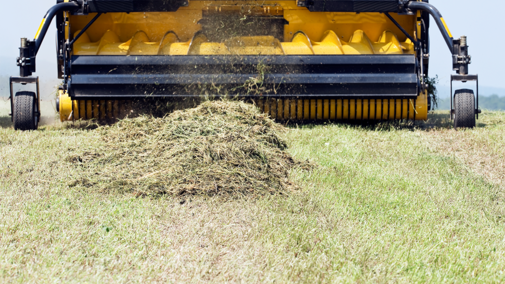Managing Windrow Disease in Alfalfa
Rained-on hay plagues all of us eventually. This year maybe more than usual. The “windrow disease” that often follows presents lingering problems.
Windrow disease — that’s the name given to the striped appearance in fields where alfalfa windrows remained so long that regrowth was delayed. Usually, it’s due to rained on hay and sometimes, insects.
Windrow disease presents special challenges. Weeds often invade, requiring spraying to maintain quality and protect stands. During the next growth period, plants that were not smothered regrow rapidly, while plants underneath the windrow suffer delays. Part of the field often will begin to bloom while windrow-stressed plants are still short and tender. So when do you harvest? When the first plants begin to bloom or do you wait until injured plants are ready?
I suggest using two factors to tell you when you should cut — the health and vigor of your stand and the nutrient needs of your livestock. For example, is your alfalfa stand young, healthy and regrowing well? If not, wait to cut until stunted plants begin to bloom so you can avoid weakening them even more.
But, if your alfalfa is in good shape, then cut when it will best meet the needs of your animals. Dairy cows need alfalfa that is cut early, so harvest when the first plants reach bud to early bloom stage. Regrowth of injured plants may be slow after cutting, but this sacrifice is needed for profitable milk production. Beef cows, though, do not need such rich hay. So, if the hay will be fed to beef cattle, let stunted plants recover, and then cut when they are ready to bloom.
Hopefully, by next cut, growth will be more uniform, plants healthy, and production back to normal.
Alfalfa Rain Delay
Continued rain this year is a blessing to keep pastures and fields growing and green. However, short drying windows may make alfalfa harvest tricky.
The timing and amount of rain is important. Legumes like alfalfa are more impacted by leaf shatter from raking or turning than grasses. A bit of moisture on new hay before drying has minimal impact, but heavy rain (greater than one inch) can cause up to 10% of soluble nutrients to leach out, with over 30% loss over multiple events.
To keep impact low, speed up the dry-down process. Spreading windrows as wide as possible, conditioning at harvest, and proper raking can reduce dry down from two days to half a day. Alternatively, consider higher moisture uses like haylage or baleage. While soil moisture and compaction still need consideration, you can clear a field in two days or less.
Finally, preservatives can be used to bale at slightly higher moisture levels without the mold and heat issues typically experienced. We can’t bale at moisture levels used for ensiling, but it does allow us to get into the field a bit sooner.
If we do need to wait for harvest, hay quality will decrease as the plant matures. While we do gain yield, taller plants are more susceptible to lodging if moisture continues. Be aware that plants may start growing new shoots from the crown as they mature. If harvest cuts off these shoots with the first growth, a second cutting can be delayed by up to a week.
Fortunately, you can avoid this delay. Scout before harvest and if new growth is present, raise your cutting height just a couple inches so you avoid clipping off most of these new shoots. Your regrowth will have a head start towards the next cutting and since the stubble you leave behind has quite low feed value anyway, the yield you temporarily sacrifice is mostly just filler.
Alfalfa Weevil Feeding on Regrowth
Since the first cutting of alfalfa has been completed in much of the state, Nebraska producers may be tempted to believe our troubles with alfalfa weevil are over. Unfortunately, this may not be the case. Alfalfa weevil feeding on regrowth has been reported in some fields, so scouting is highly recommended, particularly if you notice that regrowth doesn’t begin within four to five days after cutting.
Alfalfa plants usually suffer the most injury and economic damage before the first cutting; however, feeding on regrowth can have impacts as well. While larvae cause the most damage, adults can also cause damage by feeding along leaf margins and leaving irregular notches. Adult beetles are roughly 5mm in length with a blunt snout and a brown body covered in golden hairs. Larvae are 1.5mm to 8.5mm long with a black head, wrinkled green body, and white stripe along the back and will curl into a C-shape when disturbed.
Scouting for alfalfa weevil is simple and can help mitigate economic losses. Randomly select five sites across the field and collect 10 stems at each site, cutting the stems at ground level. Beat the stems into a deep-sided white bucket and count the number of larvae to determine the average number per stem. Economic thresholds for alfalfa weevil can vary greatly from an average of one to seven larvae per stem, depending on a variety of factors. A threshold table that includes alfalfa as short as four inches can be found on the Iowa State Extension website.
While there are several insecticides labeled for alfalfa weevil management, in Nebraska there have been reports of some products not performing as well as expected and resistant alfalfa weevil populations have recently been reported in several western states. Therefore, if you believe you have an infestation above threshold, contact your county extension office for further guidance.

